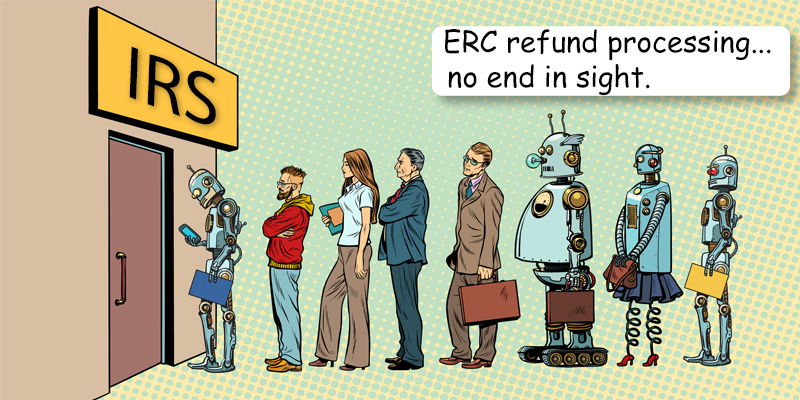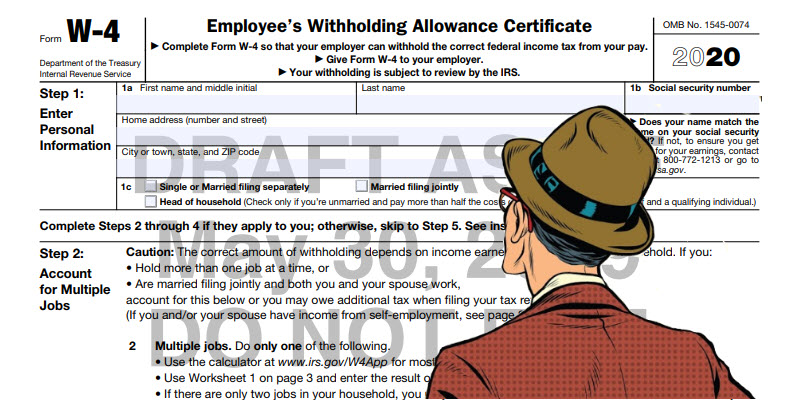Each year in January, the Taxpayer Advocate Service (TAS) presents its annual report to Congress, consisting of a summary of the ten most serious problems encountered by taxpayers each year. It may not be any surprise to those waiting for their Employee Retention Tax Credit (ERC) refund, but the most serious problems reported for this year are the IRS delays, inefficiencies and lack of transparency in their processing of these claims. Created in 1996 by Congress, the TAS is an independent organization within the IRS; their job is to ensure that every taxpayer is treated fairly under the Taxpayer Bill…
Posts tagged as “IRS”
Did you hire someone who is giving you pushback on submitting a W-4 form, or maybe they even presented you with a little-known tax form stating that they do not pay taxes? If so, you may have hired a tax protestor. No need to panic; you may be able to talk some sense into them. Tax protestors could simply be misinformed individuals, and with social media exposure, that is easy to come by. I have seen TikTok videos, X posts, YouTube and the like, falsely leading people down this path. They claim that taxation is voluntary, does not apply to…
There is a fair amount of activity with the IRS-processing Employee Retention (Tax) Credit (ERC) refunds with two announcements this past month. I would call it good news for those who have legitimate claims and bad news for those who filed a not-so-legitimate claim. Actually, not all bad news for the not-so-legitimate claim group. The IRS has reopened the Voluntary Disclosure Program (VDP), which will run through November 22, 2024. As you may recall, this was started earlier this year whereby the IRS allowed you to revoke your claim and return any funds you believe were improperly claimed, keeping 20%…
Multiple lawsuits have been filed against the IRS, alleging that their lengthy processing time for ERC claims is violating their rights, including one to stop the moratorium that was imposed on new filings made after September 14, 2023. In recent IRS responses to these lawsuits, we have learned new information on how they intend to clear their backlog of 1.4+ million returns they have had as of May 18, 2024. 880,000 of those returns were filed before the moratorium on September 14, 2023, so in essence, the fact there is a moratorium at all, those returns received after that date…
Over the next few weeks, as your employees start to receive their 2022 W-2 form, they will most likely have many questions as to what all those numbers mean. For example, it is not uncommon for a salaried employee who earns $50,000 per year question why their Box 1 Wages only reflects $45,000. Did they get underpaid? Probably not. If the employee contributes to a pension plan (aka 401(k)) or has pre-tax insurance deductions, then those amounts reduces the “taxable” wage, which is what appears in Box 1. Some employees may also wonder why their Federal Income Tax withheld is…
Over the next few weeks, as your employees start to receive their 2021 W-2 form, they will most likely have many questions as to what all those numbers mean. For example, it is not uncommon for a salaried employee who earns $50,000 per year question why their Box 1 Wages only reflects $45,000. Did they get underpaid? Probably not. If the employee contributes to a pension plan (aka 401(k)) or has pre-tax insurance deductions, then those amounts reduces the “taxable” wage, which is what appears in Box 1. Some employees may also wonder why their Federal Income Tax withheld is…
The Coronavirus Aid, Relief, and Economic Security (CARES) Act that passed in March 2020 allowed businesses to defer paying their employer share of Social Security (OASDI) taxes through the end of that year. This allowed businesses to hold on to a portion of their tax liability to get through any cash-strapped times caused by COVID-19 and basically, have an interest-free loan for a long period of time. The deferred tax would then become due in two equal installments, with half due on December 31, 2021 and the remainder due on December 31, 2022. Here we are at the start of…
Last December, President Trump signed the Consolidated Appropriations Act of 2021, which included $1.4 trillion to fund the government through fiscal year 2021, as well as a number of important tax provisions. One of the little-known and under-utilized benefits in that Act is the extension of the Work Opportunity Tax Credit (WOTC) through December 2025. The WOTC provides a general business tax credit of up to $9,600 to employers that hire and retain individuals from certain targeted groups, such as veterans, ex-felons, summer youth, SSI recipients, long term unemployed and more. This month, the Internal Revenue Service even reminded employers…
The W-4 form has remained basically unchanged for many decades. For a flashback, here is what it looked like in 1990: https://www.irs.gov/pub/irs-prior/fw4–1990.pdf. Unchanged until now, that is. The IRS has done a complete revamp of the form for 2020 by adding many additional fields for the employee to complete as well as removing ‘number of allowances.’ You may ask how that can be since the number of allowances basically dictated the amount of federal income tax withheld from a paycheck. You need to see the new form to believe it, and here it is: https://www.irs.gov/pub/irs-dft/fw4–dft.pdf. The form asks the employee…
Ever since the 2015 Obergefell v. Hodges case in which the Supreme Court of the United States ruled that the fundamental right to marry is guaranteed to same-sex couples by both the Due Process Clause and the Equal Protection Clause of the Fourteenth Amendment to the United States Constitution, it has been shown that the number of employers offering domestic partner benefits has significantly decreased. A year before the ruling (2014), a survey reflected that 59% provided benefits to same-sex domestic partners and just one year later (2016), 48% are providing benefits with that number decreasing each year. The reason…









